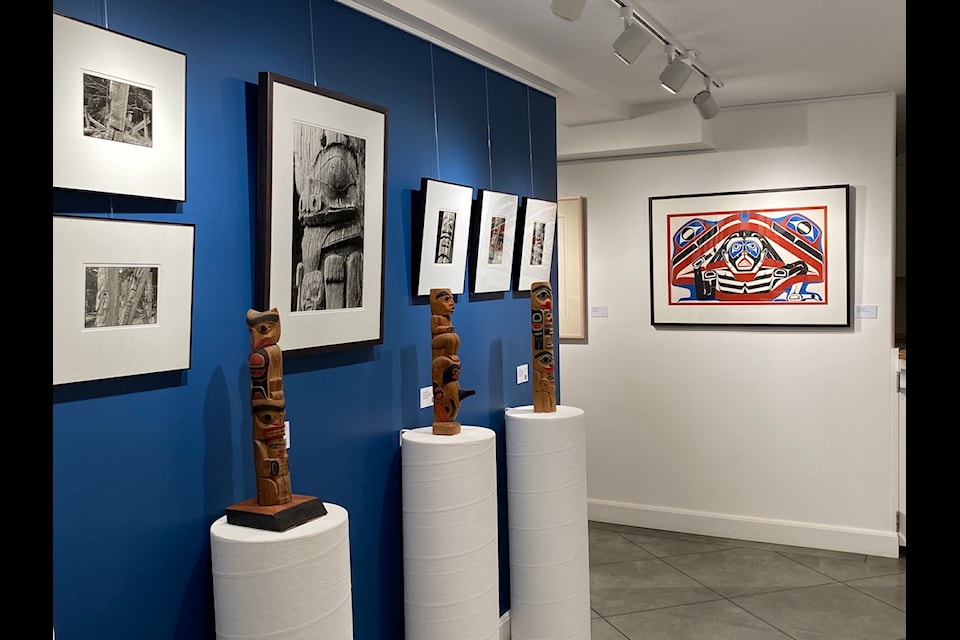Art lovers looking to learn more about Indigenous art forms will want to walk the 'Path of the Totem' exhibit at the Cowichan Public Art Gallery.
There are two parts to this exhibit sponsored by Island Savings — the first is Path of the Totem, which celebrates concept to completion of the totem poles that gave Duncan it's name 'City of Totems', from their mini maquettes to their final full size installations.
Historically, model totem poles were created as easily transportable trade items in the latter part of the 19th century to exchange with Euro-Canadian and American visitors to the region.
The traditional symbols on the model poles were derived from their existing monumental counterparts that stood in villages and dwellings up and down the coast. These gave material form to the mythological origins of the peoples, proclaiming their rights of crest ownership or territorial claims, or, in the case of memorial poles, paying respect to those who had passed before.
It wasn't until the '80s and '90s when the universal popularity of totem poles began to take shape through both public and private commissions to artists worldwide that requests for maquette poles really begin to flourish.
"What would often happen is when an artist would be commissioned to do a totem pole, they would first discuss what they had in mind, and then carve the maquette version first," said Clark.
The second part to this exhibit showcases a selection of silk screened First Nations prints from curator Fraser Clark's private collection that he has been building for the past 30 years.
"I'm a big fan of Northwest Coast Native art, and I also am hoping to educate people more on what is called Northwest Coast form line graphics," said Clark.
'Path of the Totem', which first opened on Sept. 13, has already seen more than 600 visitors, which sparked the idea to extend the exhibit until Dec. 21 due to its increasing popularity.
"It feels great to extend this exhibit, it's basically the community saying that they like it," said Clark. "We've already had six classes of school kids come in and more to come, which is fabulous. We've also had a lot of First Nation students in as well who of course are quite fascinated with the display because it's their culture. Art classes have been coming in, to sit and do drawings and renditions of the maquettes. It's actually really cool."
Originally from Vancouver Clark, who is one of many curators at the gallery, has called the valley his home since 2004. Now retired, he has been volunteering with CPAG for just over a year. He has an extensive history in the art world and ran an Indigenous Art Gallery in Toronto for 20 years and would travel back and forth to the island during that time to commission different artists. He also spent 12 years as a corporate art consultant. Clark was inspired to curate this exhibit after walking into City Hall and catching a glimpse of their huge collection of maquette totem poles.
"I was blown away by the collection and immediately said to myself this is a show — these are little gems," said Clark. "It's really cool to curate this exhibit because it is right in my wheelhouse. I not only have a love for the art form but I also really want to see this gallery grow."
Next to each maquette totem is a QR scan code which will let attendees know whereabouts in town they can can see the exact larger totem installation carved by the same artist — inspiring more to experience the touristy totem walk around town.
Clark, who also dabbles in photography, also has some of his original photos from the late 1980s from Ninstints, which is located at the south tip of Haida Gwaii, as part of the Path of the Totem exhibit.
"These are the last remaining totem poles in their original place pretty much left in B.C.," said Clark. "There are a few other scattered in places like Alert Bay, London Harbour, and a few other places but these are quite unique. I took these in 1987, and you can see by the photos the condition they were in then, so you can imagine them now."
Clark, who has already given several lectures on the exhibit and its contents since it began in September, plans to host another art cafe where he will talk about the history of totem poles and the structure of Northwest Coast graphics before the exhibit comes to a close. To stay in the loop or for more information on the exhibit or the gallery in general visit https://cowichangallery.ca/totem/.
"The history of Northwest Coast graphics isn't that well known, it just sort of arrived but there is actually quite a history to how it got here and who brought it here," said Clark. "I will also talk on the prints on display, and what both the graphics mean and portray as well as the difference between figurative and distributive graphics."
Clark says that CPAG has ambitious plans for the future, with the hopes to eventually become a multi-gallery premises in downtown Duncan with an outdoor sculpture garden.
"Eventually the big plan is to build a stand alone art gallery in downtown Duncan that will be 30,000 square feet and will cost in the neighbourhood of $30 million," said Clark
Art lovers can walk the Path of the Totem between the hours of 10 a.m. to 4 p.m., Tuesday to Saturday with a donation as the price of admission, at the gallery, located at 126 Ingram St., in downtown Duncan.
"I hope attendees take away a deeper appreciation for First Nations art work in general," said Clark. "We are also trying to raise awareness in the community that this gallery exists, that we are moving forward with big plans and that we put on a good show."



